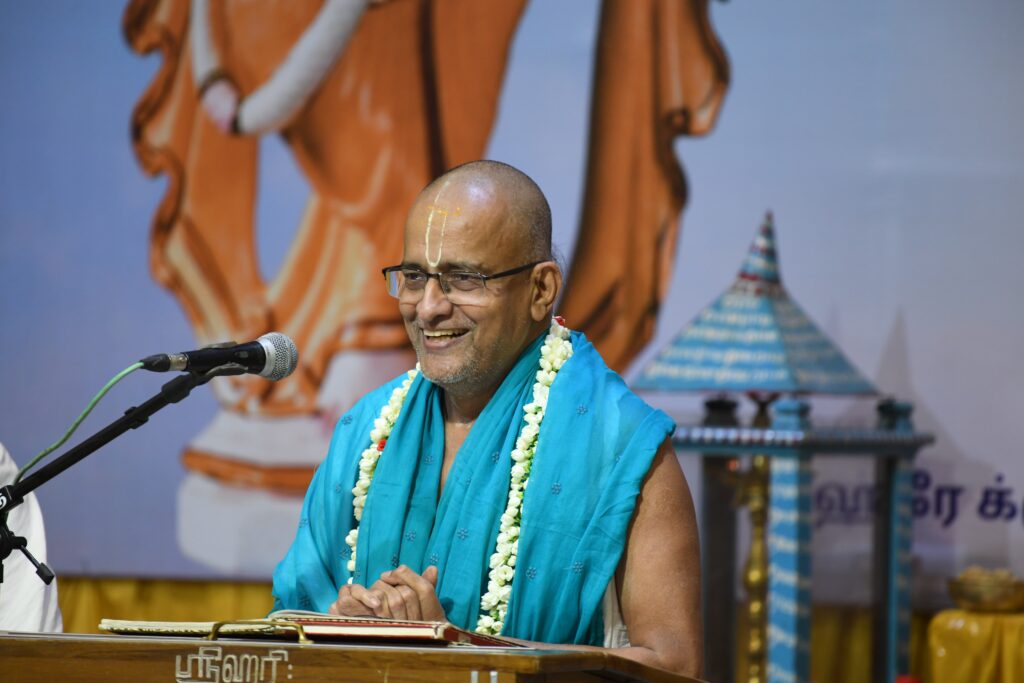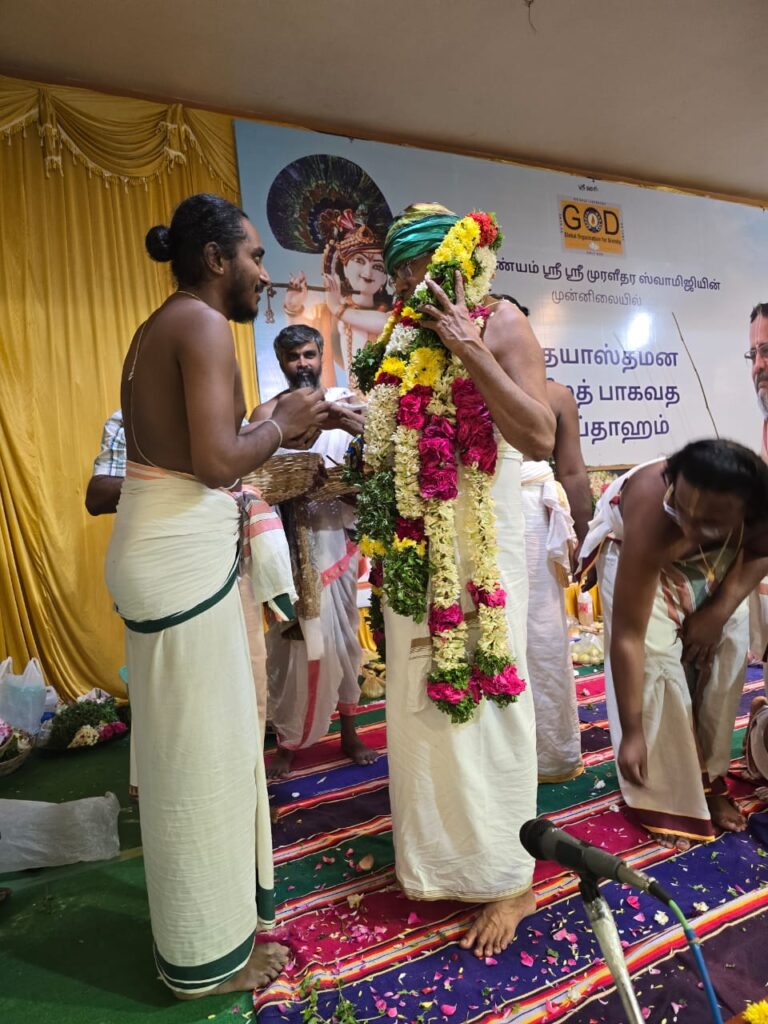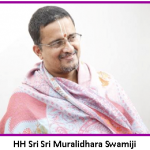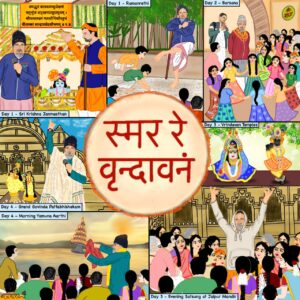
Unexpected and continuous showers of grace drenched participants at the Udayasthamana Srimad Bhagavata Saptaham held at Madurai from October 7-13, 2025.
‘Udaya-astamana’ means from sunrise to sunset. A Srimad Bhagavata saptaham conducted in this format is usually held from 6 am to 6 pm with parayanam and katha conducted alternately all day long.

This saptaham at Madurai was held in the divine presence of Guru Maharaj, His Holiness Maharanyam Sri Sri Muralidhara Swamiji. What was unique about it was that Sri Swamiji was present there continuously for the entire 7 days. He did not leave the venue, and in fact, as he himself noted on the final day, for the entire period he did not venture beyond the small area between stage, his seat and his room there. He was present for the parayanam fully, read many of the key chapters himself with deep enthusiasm, showered the avid listeners with his nectarine discourses, listened to every one of the discourses by his students; and amid all this, Sri Swamiji also showered his compassionate blessings on the hundreds of devotees who lined up every day to offer their prostrations, flower garlands and offerings, place their prayers at his feet, or simply hoping for a smile or word from him.
Sri Madurai Meenakshi, Tirumaliruncholai Kallazhagar Perumal, Koodal Azhagar Perumal, all sent their prasadam to Sri Swamiji on various days during the saptaham, and he accepted each of them joyfully and humbly.

Sri Swamiji appeared to be in a very pleasant and compassionate frame of mind throughout the week. As he himself shared on the final day, he was also moved by the shraddha of all the devotees (most of whom were from the southern parts of Tamil Nadu) who attended the saptaham, who all sat in the hall all day daily, reading and following every word of the parayanam.
Throughout the week, in many of his discourses, Sri Swamiji reiterated the need to make full use of this rare human birth that we have been bestowed with, and use it to attain the ultimate purpose of life. He emphasized time and again that all we need to do to attain the highest is simply chant the Divine Names and listen to Bhagavad katha, and place our life at the feet of Bhagavan. He also spoke of how when we go to satsang, we should not compromise the purpose for which we have come to satsang; he said do not see how others are… focus on how we are!
He also spoke of how Srimad Bhagavatam shows how a man can progress and attain the highest good. Giving the example of Sri Narada’s earlier birth, Sri Swamiji showed how Narada was born earlier as the child of a servant maid. He had no samskaras but somehow attained the company of sadhus because his mother pushed him into it. That child, because of attaining sadhu sanga, became the Sage Narada! That child, who had no background and did not know anything at all, then attained such a stature (as Sage Narada) that he told Sage Valmiki to write Ramayana, he told Sage Vyasa to write Srimad Bhagavatam, he bestowed the highest on Dhruva and Prahlada… all because of the satsang he got!
In this context, Sri Swamiji spoke of how when one faces troubles in life, he/she needs to use it to attain Bhagavan. The purpose of suffering is to turn one’s mind towards Bhagavan. But the key point here is, this will not happen merely on someone facing troubles in life. It will happen only if the person is first given satsanga, shown that Bhagavan is there, shown that the highest purpose of our life (the goal of all Purusharthas) is to attain Him. After that, if the person faces difficulties they will come running and hold on tight to Bhagavan.
On the other hand, if only troubles are given, without the person being blessed with satsanga, then he/she won’t come to Bhagavan. They will only think of other ways to get out of the difficulty or even think of committing suicide, etc.
What would the same boy (Narada in his earlier life) have done when his mother died, if he were not already blessed with sadhu sangam and if he had not listened about Bhagavan from those sadhus? Would he have turned to Bhagavan? Certainly not. He would have cried and just lived a life of misery and dependence on others, or even tried to end his life perhaps. But since he got sadhu sangam, he understood that attaining Bhagavan was the goal, and so when he had no one else, he held on to Bhagavan tightly.
King Parikshit was cursed that he would die in seven days through snakebite by the divine snake Takshaka. Parikshit was a powerful king. If he had not had satsanga, he would have simply resorted to trying to destroy Takshaka, or find ways to increase his longevity, or perform actions to mitigate the curse, etc. But Parikshit was one who had seen Bhagavan when he was in the womb itself, and being the grandson of the Pandava family, he had had satsanga with Krishna’s devotees all his life. So when he was faced with his dire situation, he got jnana, and went in search of Bhagavan instead.
Sri Swamiji also gave examples of Jadabharata and Gajendra both of whom turned to Bhagavan when faced with difficulty in life, because of the past satsanga they had had. Then Sri Swamiji emphasized how prayers are stronger and more sincere when we are suffering. Let’s say, he said, we go to a temple on our birthday, with plans to go for a movie afterwards. If the deity’s screen is closed and they say that it may take a little time to open it for darshan, we may not wait, and may think that we can come back another day. But say we go to the temple because we are in serious trouble, if the screen is closed, we would be willing to wait as long as needed to have Bhagavan’s darshan and place our prayers at His feet. In this same note, Sri Swamiji also pointed out how prayers in hospitals are very strong and sincere.
Thus, when we are in satsanga and the company of a mahatma, suffering can enable us to turn more deeply towards Bhagavan.
*******************************************************
Click here to go back to Nov 2025 newsletter contents page: https://godivinity.org/newsletters/nama-dwaar-newsletter-november-2025/






